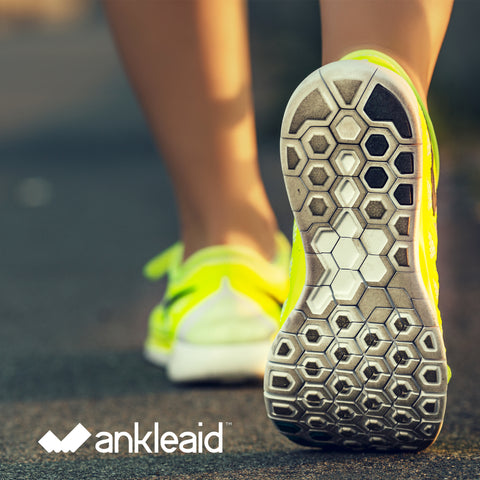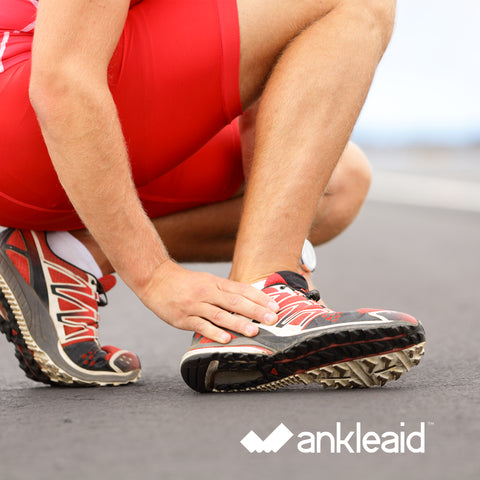
Tissue treated in cold-water immersion remains cooler significantly longer which translated means a better therapeutic treatment. However, patients tend to have an aversion to full foot immersion because of the cold discomfort to the toes (personal clinical experiences). The most common method of reducing the toes discomfort is to apply a ‘toe cover’, which reduces the amount of cold water reaching the toes, but many patients still prefer ice bags. The AnkleAid is a single foot cold-water immersion device, which features a preformed area for placing the injured foot, which ensures a 360 degree cold-water immersion and keeps the toes out of the water for patient comfort. The application of cryotherapy ranges from acute injury (e.g. ankle sprains), gout, malleolar fractures, rheumatoid arthritis, plantar fasciitis, achilles tendonitis post surgical and post rehabilitation therapy.
This post was contributed by Professor Lennart Johns at Quinnipiac University.

A recent report by Rupp, etal. (2012) compared the cryogentic effects of crushed ice bag versus cold water immersion. The results demonstrate that both methods work equally well in decreasing tissue temperature and there was no statistical difference in the amount of time required to cause a decrease of 8 degrees Celsius. The significance of this study lies in the time required for the tissue to return to normal temperature. Specifically, the tissue that was cooled via cold-water immersion remained cooler significantly longer, which translated clinically, suggests that cold-water immersion would decrease the amount of secondary cell injury as compared to ice pack applications. The longer rewarming time is likely due to cooling the tissue 360 degrees around the entire limb as compared to the ice bag application, which cools unidirectional (Rupp etal, 2012). This entire limb cooling becomes important especially in the acute ankle injuries; because many moderate to severe lateral ankle sprains result in soft tissue on the medial side of the ankle.
This post was contributed by Professor Lennart Johns at Quinnipiac University.

The use of cryotherapy is considered the standard of care for acute injury across the medical field. The primary physiological goals when using cryotherapy is to decrease tissue temperature, which in turn decreases cellular metabolism, the utilization of anaerobically produced ATP, lactic acid concentrations and secondary cell injury. Clinically, the decrease in secondary cell injury translates to a decrease in the extent of the injury and a quicker recovery, return to daily activities and work. The application of cryotherapy ranges from acute injury (eg. ankle sprains), gout, malleolar fractures, rheumatoid arthritis, plantar fasciitis, achilles tendonitis post surgical and post rehabilitation therapy.
This post was contributed by Professor Lennart Johns at Quinnipiac University.

"I have suffered with plantar fasciitis for as long as I can remember. I’ve had cortisone shots, I wear orthotics, and I stretch regularly. Yet, I still suffer with soreness in my arch and on my heel. Flare-ups range from minor to major, depending on how much activity I engage in that day.
For the days when it's really hurting, deep tissue massages coupled with ice therapy are the doctor's orders. But let's face it - ice therapy is torture. Many doctors tell you to dunk your entire foot into an ice bucket, which according to them is the best method to get the full tissue treatment. This is so unbelievably painful because my toes are so sensitive that they almost immediately freeze and I can’t take the pain associated with that. I discovered a product called AnkleAid. This is a neat product that allows you to soak my ankle in ice-cold water with my toes out, which is great because they are so ultra-sensitive. A 10-minute soak in the AnkleAid is all it takes to gain relief from the pain.”
Note: AnkleAid can also be used with hot water as well.

AnkleAid can be used by athletes for recovery from fitness injuries and is an affordable way to treat sprained ankles, plantar fasciitis, Achilles injuries and a host of other foot/ankle issues. For people with chronic pain, AnkleAid can be used to help alleviate this through ice and heat therapy, and help you lead a more fulfilling and relatively pain free life. The AnkleAid is able to provide both cold and hot therapy, so it’s an all-in-one solution for certain foot and ankle issues.

Plantar Fasciitis is not a well-known foot ailment. Plantar Fasciitis is the Latin name for the more commonly known ailment, Jogger’s or Policeman’s heel. Although not very well known, it is very common and thought to affect a large portion of the population. Common causes are; standing for long periods, obesity and over exercise. While not a serious medical condition the shooting pain it causes in the bottom of the foot and heel can be excruciating. Fortunately, it can usually be treated at home with contrast therapy achieved with two AnkleAid’s. Contrast therapy is highly recommended by many doctors and includes alternating between a cold and hot foot bath.

Plantar fasciitis is a common cause of heel pain. It is pain and inflammation of thick tissue, called the plantar fascia. The fascia spans the bottom of the foot and connects your toes to your heel bone.
The pain most often occurs first thing in the morning after getting out of bed and includes stabbing pain that normally lessens after normal daily activity. It is most common in runners or overweight people. Pain relievers, physical therapy, night splints or orthotics may help improve plantar fasciitis.
Contrast therapy is highly recommended by doctors to offer relief to plantar fasciitis patients. This therapy includes alternating hot and cold baths. The best product to achieve this therapy in an efficient and cost effective way is the AnkleAid. The product is inexpensive and the perfect size to be able to utilize two AnkleAid’s in a small space.

Plantar fasciitis is thickening of the plantar fascia, a band of tissue running underneath the sole of the foot.

Normally the majority of people who suffer from Plantar fasciitis are:
- Overweight
- Runners (especially distance runners)
- On their feet for several hours each day
- Have medical conditions such as rheumatoid arthritis or lupus
Plantar fasciitis can be treated many ways. Rest is critical. If possible, stop daily activities that are causing your heel pain. Wear shoes with good cushion and the right arch support for your foot such as running shoes.
A great way to treat plantar fasciitis is to use contrast therapy also known as "hot/cold immersion therapy." One of the easiest ways to treat yourself with contrast therapy is by using 2 AnkleAids.
- Start by immersing your foot for 3 minutes in the hot water filled AnkleAid.
- Then immerse in the cold water filled AnkleAid for 1 minute.
- Repeat these steps 4 to 5 times.
The AnkleAid is designed to allow your feet to sit comfortably with a slight stretch, making sure that you get the best treatment possible. AnkleAid can be also be used to treat sprained and broken ankles, Achilles injuries, and even elbow injuries.
Visit our Contrast Therapy page for more information.
















